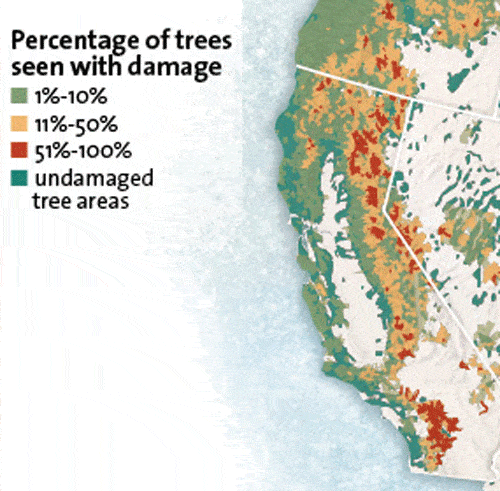
I remember in the seventy’s I had built a home for a client. He insisted that I build the front deck such that it wrapped around some large pine trees. We finished the house in the middle of a drought. Soon enough the bark beetles hit his trees and they died. We are back again with an explosive growth of bark beetles.
Local, state and federal officials are virtually helpless against the pestilence, which has turned hundreds of thousands of acres of forest brown and left huge fire-prone stands of dead wood.
The trees are being devoured by millions of native beetles, each about the size of a grain of rice. The insects, thriving in the warm weather and lack of freezing temperatures, are overwhelming the defenses of water-starved trees, attacking in waves and multiplying at a frenzied pace, depositing eggs under the bark that hatch into ravenous larval grubs.

Mountain pine beetle (photo: U.S. Forest Service)
“Things are looking really, really bad,” said Tom Smith, a forest pest management specialist for the California Department of Forestry and Fire Protection. “Basically we’ve got native bark beetles that are attacking the pines. They are only successful in attacking the trees when the trees are stressed. Right now all the trees are stressed because of drought.”
The infected trees are on private and public lands, in national parks, wilderness areas and managed forests. There seems to be no solution short of removing the dead and dying trees and hoping against hope for rain and cold. The worst of it is in the southern part of the state, but pest management experts say the plague is moving north.
A healthy tree can usually beat back invading beetles by deploying chemical defenses and flooding them out with sticky resin. But just as dehydration makes humans weaker, heat and drought impede a tree’s ability to fight back—less water means less resin. In some areas of the Rocky Mountain West, the mid-2000s was the driest, hottest stretch in 800 years. From 2000 to 2012, bark beetles killed enough trees to cover the entire state of Colorado. “Insects reflect their environment,” explains renowned entomologist Ken Raffa—they serve as a barometer of vast changes taking place in an ecosystem.
Sheri Smith, the regional entomologist for the U.S. Forest Service in California, said bark beetle and drought-caused tree mortality more than doubled across forests in California last year and is expected to increase even more this year. The Forest Service mapped tree mortality across 820,000 acres of forested land in 2014 compared
with 350,000 acres in 2013, according to the service’s annual Aerial Detection Survey Program results. The results of this year’s surveys, which are just getting under way, are not expected until later in the year.
Related articles
Help keep this blog going
Call or write today for all your
real estate needs
John J. O’Dell Realtor® GRI
O’Dell Realty
(530) 263-1091
EMail John O’Dell
BRE#00669941
Error: Contact form not found.
